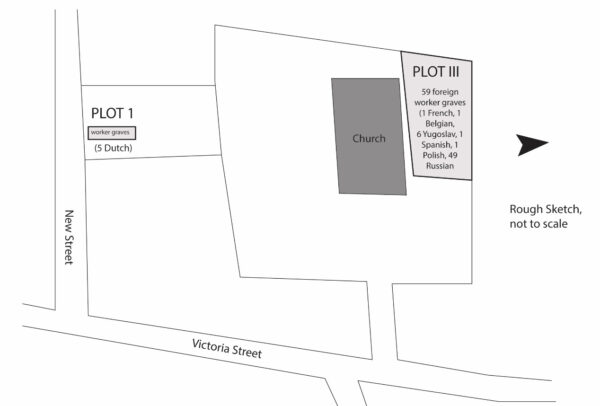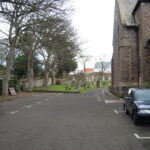St Anne Cemetery
- Country: Alderney, The Channel Islands
- GPS: 49° 42' 55.08 N, -2° 12' 17.2188 W,
- Address: 3 Queen Elizabeth II St, St Anne
- Operational: 01/04/1942 - 01/06/1944
By Caroline Sturdy Colls and Kevin Colls
After the death of a forced, slave or less-than-slave-labourer was registered, in theory, a system was in place whereby ambulance drivers and a one-eyed gravedigger would collect their corpse for burial.1 A cross bearing the name, date of birth and date of death of the deceased was then supposed to be inscribed and erected immediately in one of the island’s official cemeteries. The first of these was an existing cemetery in St Anne. It was positioned just off the high street in the centre of town, adjacent to the parish church.
When British investigators arrived in Alderney immediately after liberation (May 1945), they stated that sixty-five burials of OT workers were evident in St Anne’s cemetery, based on a visual inspection of the site and burial lists.2 At this time the graves were marked with crosses and the names on them were legible.3
Except for one burial in May 1943 and two in June 1944, the burials in St Anne consisted of OT workers who died between April and November 1942; hence, this was the island’s first official labourer cemetery.4 The dates displayed on the crosses in the main burial area indicate that the majority of those buried here died in September, October and November 1942, consistent with reports indicating a high death toll during this period Assuming these dates are accurate and that no further graves exist, it appears that the cemetery at St Anne was used only for a short time.
Further analysis of witness testimony, documents, photographs and the results of the exhumations carried out by the VDK in 1961 coupled with archaeological investigations, suggest that the reality of the burial ‘system’ was quite different than the official procedures suggest. While aesthetically the cemetery appeared to have been reasonably well maintained, when the burials are considered in spatial terms, it is evident that they were not as orderly as they originally appeared. Although some crosses were in chronological order, the majority were not, at least by the time the island was liberated. Some crosses marking similar dates of death were scattered across the graveyard. It seems unlikely that graves would have been positioned in such a scattered fashion – not least because they formed a neat grid by the time the cemetery ceased to function. Therefore, it is likely that either the crosses were not erected immediately after burial and were instead placed on the graves sometime later, or the crosses were erected when the burials took place but were removed before being re-erected at some point during the occupation. This is somewhat corroborated by testimony of OT Frontführer Johann Hoffman who reported that the cemetery of St Anne’s church had no crosses in 1944.5
Other tell-tale signs of the chaotic nature of the cemetery can also be found. For example, Ferdnand Lardin had two crosses bearing his name within the cemetery, while there were also rumours that a German Wehrmacht soldier named ‘Minarek’ was buried in ‘a common grave with members of the former Todt Organization’.6
When exhumations were carried out within the cemetery in 1961 by the VDK, only fifty-eight bodies were recovered. Undoubtedly, vagueness about how many bodies were present stemmed from the chaotic nature of the German approaches to burial. In a letter to the IWGC, the VDK wrote:
‘in spite of every effort by our exhumation team, only 58 dead were exhumed from St. Anne Churchyard on the Island of Alderney. That is to say 53 dead from an enclosed plot to the north side of the church and 5 dead from Plot 1, Row E well to the south of the church. In spite of wide-ranging probing at the time of the exhumation of the 58 dead referred to we could fi nd no traces of the 5 [sic] burials which are missing. It cannot be excluded that the missing burials could not be found by over-burial of civilians. We did not, however, wish to interfere with the civilian burials’.7
Some of the confusion surrounding the location of these graves is also likely due to renovation works carried out in the 1950s. By the time the International War Graves Commission (IWGC) visited Alderney in 1952, they observed of St Anne’s cemetery that ‘all foreign worker graves with the exception of 3 Dutch in Plot I are unmarked’.8 In the same year, the States of Alderney informed the IWGC and British government that they would not be willing to pay for new individual markers for the graves ‘as there is no guarantee whatsoever that the remains are actually buried in the particular space indicated’.9
Therefore, knowledge of some of the locations of the graves appears to have been lost by the time the exhumations in 1961 took place. Looking at the methodology used by the exhumation team, it is evident that the body recovery process was not thorough and that it certainly did not meet the standards that would be expected during exhumations today. First, no report detailing the actual excavation procedures is available, making it difficult to know exactly what the investigators found.10 Secondary sources indicate that the exhumations were undertaken hastily and only basic information about them noted down. The VDK did not employ professional body recovery specialists nor scientists and local volunteers appear to have been used to help with the exhumations.11 Following the exhumations, the northern burial area was converted into additional car parking for the church.
References:
1 TNA, WO311/12, ‘Statement by Pomar Pascual’, 10 August 1945; TNA, WO311/11, ‘Statement of Charles Synderick Risbrider’, 1945; TNA, WO311/11, ‘Statement of John Sidney Pinel’, May 1945.
2 TNA, WO311/677, ‘Alleged Atrocities on the Island of Alderney’, 30 May 1945; TNA, WO311/13, ‘Report No. PWIS(H)/KP/704 on Alderney Atrocities No. 2’, 18 July 1945.
3 Island Archive, AQ 875/03, ‘Appendix No. 1. Protocol’, 10 June 1945; These investigators refer to 53 Soviet citizens being present in the cemetery, along with 10 other individuals whose names or nationality was unknown.
4 For lists of graves created by Captain Kent in 1945 and Mr Watson from the IWGC in 1953 respectively, see Appendix F in TNA, WO311/13, ‘Report No. PWIS(H)/KP/702, Report on Atrocities Committed in Alderney (1942–1945)’, 27 June 1945 and TNA, FO371/106597, ‘List of Soviet Citizens buried in St Anne’s churchyard, Alderney’, 8 July 1953.
5 TNA, WO311/13 ‘Statement by OT Frontführer Johann Hoffmann’, 1 August 1945; TNA, WO311/13, ‘Report No. PWIS(H)/KP/709, Periodical Report on Alderney Atrocities No. 4’, 11 September 1945.
6 TNA, HO284/84, ‘Exhumation of members of the former Todt Organization in Guernsey and Alderney/Channel Islands’, 8 August 1961; TNA, FCO 33/4872, ‘Exhumation and Transfer of German War Dead in the British Channel Islands’, 5 February 1962; CWGC, 7/4/2/10822, ‘List of German War Graves. Alderney. St Anne’s Churchyard’, 7 December 1961.
7 CWGC, 7/4/2/10821, ‘German Graves in the Channel Islands’, 29 March 1963.
8 TNA, PRO FO 371/100916; The IWGC is now known as the Commonwealth War Graves Commission (CWGC).
9 TNA, PRO FO 371/100916, ‘Alderney Channel Islands, Alderney (St Anne) Churchyard, Foreign Worker’s Graves’, 1952.
10 Volksbund Deutsche Kriegsgräberfürsorge, pers. comm; Although some detail was provided in 1963 concerning the graves exhumed in St Anne’s and the German Military Cemetery, the part of the letter concerning Longy Common was missing in both the CWGC and TNA files. The list of exhu-mations from Longy Common within the archives of Volksbund Deutsche Kriegsgräberfürsorge lists mostly unknown individuals, even though the names of the labourers were provided in lists compiled in 1945 and 1952.
11 J.F.W. Main, ‘Leave Sylt alone’, Alderney Press 27 (2017).
Map
- Cemetery / Mass Grave
- Concentration Camp
- Forced Labour Camp
- Prison
- Worksite / Fortification



